Lab 1: Intro to DC Circuits
ECE202 - Electrical Circuits I
Electrical and Computer Engineering - University of Alberta
1 Objectives
In this first lab session, you will become familiar with some of the common electrical tools and components used for circuits and use them to experimentally test and confirm the validity of concepts taught in the lectures. The objectives are as follows:
Introduce the following devices:
- DC Voltage and DC Current Sources
- Resistors and a Potentiometer
- DC Voltmeter, DC Ammeter and an Ohmmeter
- A Breadboard
Introduce the following concepts:
- Ohm’s Law
- Power Dissipation of a Resistor
- Kirchhoff’s Laws - (KVL and KCL)
- Series/Parallel Resistors
- Voltage/Current Dividers
- The Loading Effect - Voltmeter Loading
1.1 Equipment Required
- The Lab 1 - Results sheet to record your measurements.
- USB Power Supply
- A USB A to Micro-B cable
- USB Breakout Board
- Digital Multimeter (User Manual )
- MB102 breadboard
- DC Current Source
- Jumper Wires
- 1kΩ pot
- The following Resistors (1/4 watt, 1% or 5%)
- 10Ω
- 100Ω
- Two 470Ω
- 1kΩ
- 4.7kΩ
- Two 10MΩ
2 Procedures
2.1 Equipment Familiarization
2.1.1 Resistors
A resistor is a passive electrical component to create resistance in the flow of electric current. They can be found in almost all electrical networks and electronic circuits.
The unit of measure for resistance is Ohms (Ω) in the International System of Units (SI). The Ohm is the resistance of a conductor such that a constant current of one ampere in it produces a voltage of one volt between its ends.
Therefore the current is proportional to the voltage across the conductors terminal ends. This ratio is represented by Ohm’s law:
\[I = \frac{V}{R}\] Where:
- I = the current through the conductor in amperes.
- V = the voltage across the conductor in volts.
- R = the resistance of the conductor in Ohms.
Resistors are used for many purposes. A few examples include to limit electric current, voltage division, heat generation, matching and loading circuits, control gain, and fix time constants. They are commercially available with resistance values over a range of more than nine orders of magnitude. There size and power ratings very greatly as they can be very large when used as electric brakes to dissipate kinetic energy from electric trains, or be smaller than a square millimeter for use in a smartphone.
More information - Wikipedia - Resistor

Fixed Resistor Schematic Symbol (ANSI left, IEC right)
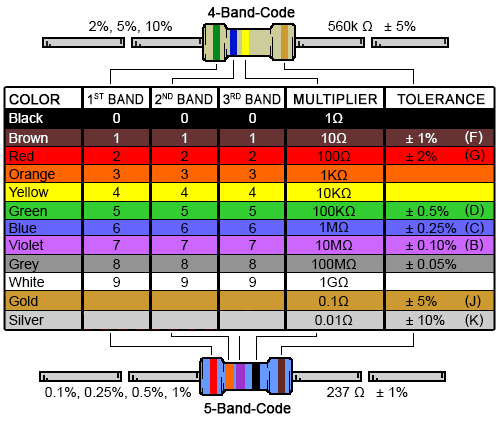
Resistor Color codes
Note:
The last band notes the tolerance of the resistor which means that the actual resistance value can be slightly different then the rated one by that percentage over its operating temperature range.
2.1.2 Potentiometer
A potentiometer is a manually adjustable variable resistor with 3 terminals. The two outer terminals are connected to both ends of a resistive element, and the middle terminal connects to a sliding contact, called a wiper, moving over the resistive element. The resistive element can be seen as two resistors in series where the sum is the “potentiometer resistance rating”, where the wiper position is the dividing point between the first resistor and the second resistor.
More information - Wikipedia _Potentiometer

Potentiometer Schematic Symbol (ANSI left, IEC right)
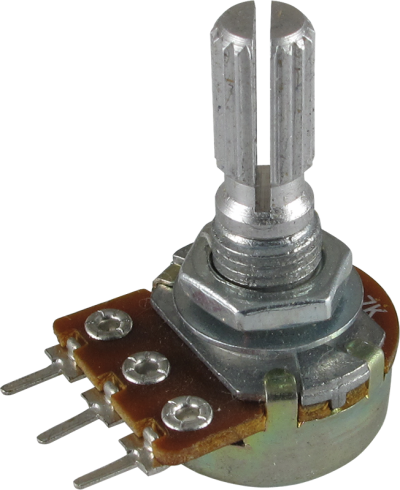
Potentiometer
2.1.3 Breadboard
A breadboard is a rectangular board with regular spaced holes for easily creating electrical connections between electronic components, a typical one is shown below. Due to the easy assembly of electrical connections these boards are mostly used to prototype circuits however they do have their limitations (ie. higher frequency design). The connections aren’t permanent and they can be removed and placed again and again.
The breadboard will be used to build the basic circuits used in these labs.
The vertical columns comprising of a pair of 5 interconnected holes are called terminals, while the 4 horizontal long rows are called power rails; These power rails are mostly used to connect the power supplies to the breadboard and are marked by red and blue lines in the image below and forming 4 separate groups of interconnected holes.
The reason it’s called a breadboard dates back to when electronics components were much bigger and people would actually use wooden breadboards (boards used to cut bread) to connect electronic circuits. Fortunately, things have changed since then and only the name has been retained.
More information - Wikipedia Breadboard
Video - Breadboard tutorial: How to use a breadboard (for beginners)

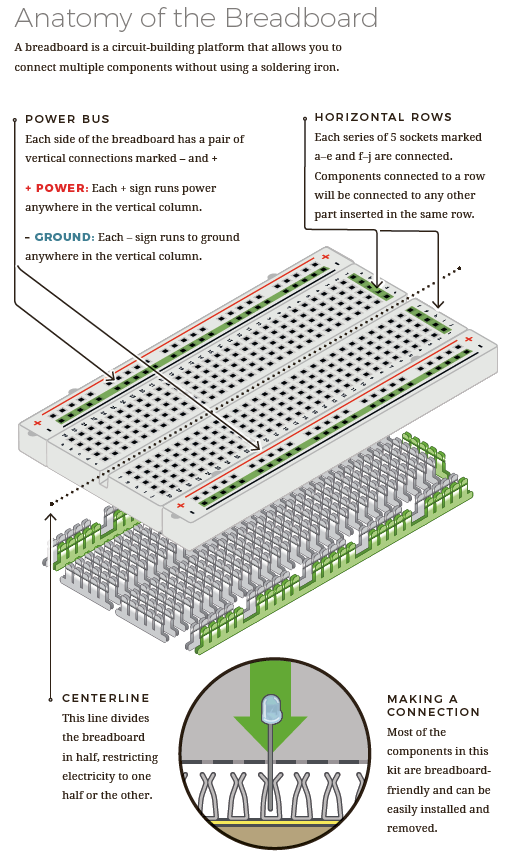
Typical Breadboard
2.1.4 USB Power Supply
For this laboratory we are going to use a simple USB Power Supply to power our experimental circuits. A USB power supply has an output voltage of +5V DC. To do this we require 3 components: The wall adapter, A micro USB cable and the micro USB breakout board.
- Connect the micro USB cable to the breakout board as shown below.

micro USB to breakout board
- Connect the micro USB breakout board as shown to the breadboard. Notice that only 2 of the pins are populated. The +5V pin and GND pin. These are the pins that are used to supply power. The other pins are used to transmit data and will not be used. It is important that you connect the micro USB breakout board as shown as connecting it to the breadboard in the wrong spot could potentially short out the +5V supply.

USB breakout on breadboard
- plug in the other end of the USB cable to the wall adapter and plug that in to a nearby outlet as shown below. The +5V power should now be available on the breadboard.

USB Power Supply plugged in
2.1.5 Digital Multimeter (DMM)
A digital multimeter is a test tool used to measure electrical quantities, principally: voltage (volts), current (amps) and resistance (Ohms). It is a standard diagnostic tool for engineers in the electrical/electronic industries.
Digital multimeters long ago replaced needle-based analog meters due to their ability to measure with greater accuracy, reliability and increased impedance.
Digital multimeters combine the testing capabilities of single-task meters; ie. the voltmeter (for measuring volts), ammeter (amps) and ohmmeter (Ohms). Often, they include several additional specialized features or advanced options. Engineers with specific needs, therefore, can seek out a model targeted to meet their needs.
The face of a digital multimeter typically includes four components:
- Display: Where measurement readouts can be viewed.
- Buttons: For selecting various functions; the options vary by model.
- Dial (or rotary switch): For selecting primary measurement values (volts, amps, Ohms).
- Input jacks: Where test leads are inserted.

DMM
2.1.5.1 Resistance Measurement
Prepare the digital multimeter (DMM) to measure a resistor.
- If you haven’t installed the battery in your DMM, please do this first. You will need an appropriate screw driver to remove the back cover to install the provided 9V battery.

DMM Battery
Connect a red banana lead to the Ω input on the bottom right of the device.
Connect a black banana lead to the COM input on the bottom of the device.
Turn the meter on by rotating the control select knob to Ω (ohmmeter).
When nothing is connected between the red and black banana leads it should display OL indicating an open circuit or infinite resistance.
When you connect (short) the red and black test leads ends together it should display approximately 000.0 indicating a short circuit or zero resistance.

Short Circuit
- Connect the red and black alligator clips to the appropriate test lead as this will make it easier to measure the resistances in the next part.

Add alligator Clips
Use the resistor color code chart above to find the resistance values in the chart below. Write the color bands required for each resistor value and write the colors on the results page. Then use the digital multimeter to measure the actual resistance value of each resistor and record it on your results sheet. To measure the resistance connect the red and black alligator clips to either end of the resistor. These are the resistors that you will use throughout this first lab so keep them handy.

Measure Resistance
Measure Resistance | |||||
R1 | R2 | R3 | R4 | R5 | R6 |
10 | 100 | 470 | 1k | 4.7k | 10M |
Measure resistors in series.

Series Resistors
- Use the breadboard to place the resistors in the table below in series as shown in the image below.

Measure Series Resistors
- Use the alligator clips on the leads of the resistors to measure the effective resistance of the two components in series and record your measurements on your result sheet.
Measure Series Resistors | ||
RS1 | RS2 | RS3 |
100 + 470 | 1k + 4.7k | 10M + 10M |
Measure resistors in parallel.

Parallel Resistors
- Use the breadboard to place the resistors in the table below in parallel as shown in the image below.

Measure Parallel Resistors
- Use the alligator clips on the leads of the resistors to measure the effective resistance of the two components in parallel and record your measurements on your results sheet.
Measure Parallel Resistors | ||
RP1 | RP2 | RP3 |
100 // 470 | 1k // 4.7k | 10M // 10M |
2.1.5.2 DC Voltage Measurement
Note:
An ideal voltmeter is an open circuit.
Use the digital multimeter (DMM) to measure a dc voltage.
Prepare the DMM to measure a DC voltage.
Make sure the red banana lead is connected to the V input the bottom right of the device.
Make sure the black banana lead is connected to the COM input on the bottom of the device.
Turn the meter on by rotating the control select knob to V (voltmeter).
Press the function button (FUNC) until DC is selected at that top of the screen.

DC Function
Connect the DC voltmeter to the USB Power supply using either header pins or jumper wires:
Connect the red probe of the DMM to the 5V pin of the USB breakout using the breadboard.
Connect the black probe of the DMM to the GND of the USB breakout also using the breadboard.

Measuring Supply Voltage with the DMM
The output voltage should be displayed on the DMM.
Disconnect the DMM from the breadboard.
2.1.5.3 DC Current Measurement
Note:
An ideal ammeter is a short circuit.
This part just explains how to setup the DMM to measure a DC current. You won’t actually measure a current here but you will use it in the next section.
Prepare the DMM to measure a DC current.
Make sure the red banana lead is connected to the (mA) input the bottom right of the device and the black to the COM input.
Note:
Most DMM’s have multiple inputs for current so that different ranges of current can be measured accurately. This one has 2 separate inputs: One for larger currents that are less than 10 amps on the bottom left, and one on the bottom right for currents in the mA and uA ranges (internal fuse rated at 630 mA).
Turn the meter on by rotating the control select knob to mA (milliamps).
Press the function button (FUNC) until DC is selected at that top of the screen.
To measure a current with a multimeter you usually need to insert the meter in series with the device you wish to measure the current through as shown below.

DMM current connection
Note:
When altering a circuit, like when adding an ammeter, it is good practice to turn off any power applied to the circuit while the changes are being made.
2.2 Ohm’s Law and Power
Ohm’s Law
The current through a resistor in amps (A) is equal to the voltage across the resistor (V) divided by the resistance of the resistor R in Ohms (Ω):
\[I = \frac{V}{R}\]
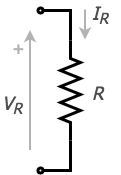
A Resistor
Power Dissipated in Resistors
Any resistance in a circuit that has a current flowing through it dissipates power. This electrical power is converted into heat energy and this is why resistors have a power rating. This rating is the maximum power that can be dissipated from the resistor without it burning out. The rate at which the electrical energy is converted to heat is the power of dissipation.
\[P = I_R^2 \cdot R\]
Experiment with the concepts of both Ohm’s Law and Power Dissipated in Resistors by connecting the circuit below and following the required procedures.
Click here to see a simulation demo of this circuit.

ohm’s law circuit
Connect the circuit above using the following:
Use the already connected 5V USB power supply to supply power to the circuit. Remember the supply is already on, so it is recommended to make the jumper connection to the 5V the last connection you do.
A 100Ω resistor.
As we only have 1 DMM, first connect it as a voltmeter to measure the voltage across the resistor. Use jumper wires or headers to connect the DMM probes to the breadboard as we are going to be switching out the resistor for different values.
It should look something like this when completed.

Measuring voltage across a resistor

Measuring voltage across a resistor
Replace the resistor with first a 470Ω and then a 1.0kΩ followed by a 4.7kΩ measuring the voltage across each resistor making sure to record all of your measurements on the results sheet.
Note:
When you make your measurements if you have it connected like shown in the images you should measure a positive voltage and current.Now that all of the voltage measurements across each resistor has been obtained we are going to remove the DMM from the circuit so we can now use it as a milliammeter to measure the current through the resistor.
Restore the 100Ω resistor.
Remove the 2 jumper wires that connect the DMM leads to the circuit.
Remove the jumper wire that connects the 5V of the USB breakout to the resistor. Replace that jumper wire with the DMM as a milliammeter. To do this connect the red DMM probe using the jumper wire to the 5V and the black DMM probe to the resistor. Make sure that the DMM is setup properly to measure milliamps as discussed previously.
It should look something like this when completed.

Measuring current through a resistor
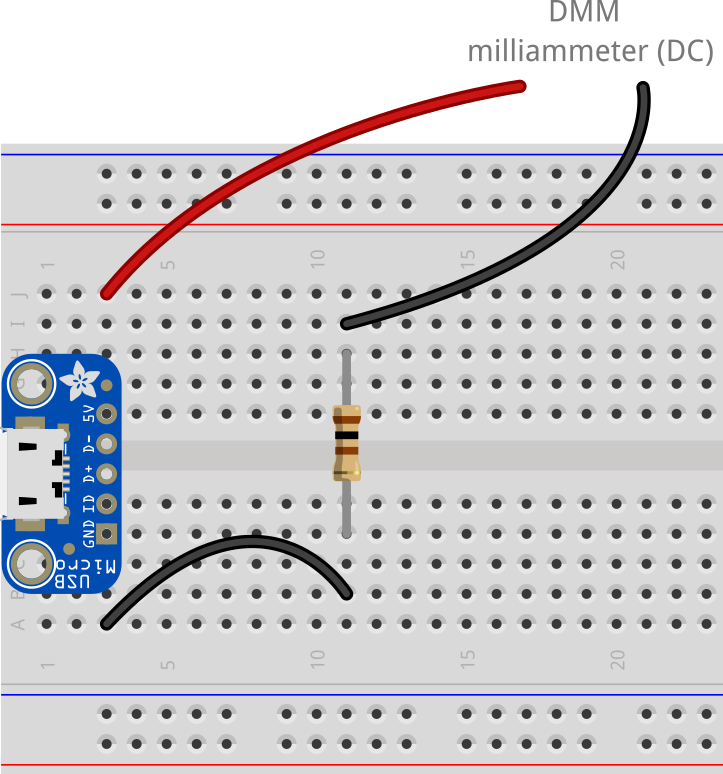
Measuring current through a resistor
- Once all of the required measurements are obtained and checked, disconnect the circuit only leaving the 5V USB breakout connected on the breadboard.
2.3 Voltage Divider
Kirchhoff’s Voltage Law
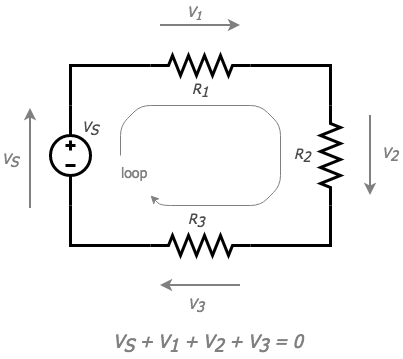
Kirchhoffs Voltage Law
Kirchhoff’s Voltage Law (KVL) is one of his fundamental laws we can use for circuit analysis. His voltage Law states that for a closed loop series path the algebraic sum of all the voltages around any closed loop in a circuit is equal to zero. This is because a circuit loop is a closed conducting path so no energy is lost.
In other words the algebraic sum of ALL the potential differences around the loop must be equal to zero as: \(\Sigma V = 0\). Note here that the term “algebraic sum” means to take into account the polarities and signs of the sources and voltage drops around the loop.
This idea by Kirchhoff is commonly known as the Conservation of Energy, as moving around a closed loop, or circuit, you will end up back to where you started in the circuit and therefore back to the same initial potential with no loss of voltage around the loop. Hence any voltage drops around the loop must be equal to any voltage sources met along the way.
Experiment with Kirchhoff’s Voltage Law by connecting the circuit below and following the required procedures.
Click here to see a simulation demo of this circuit.

voltage divider circuit
Connect the circuit above using the following:
Use the already connected 5V USB power supply as the voltage source VS. Remember the supply is already on, so it is recommended to make the jumper connection to the 5V the last connection you do.
Use a 470Ω resistor for R1 and a 100Ω resistor for R2. Place the 2 resistors on the breadboard in series.
As we only have 1 DMM, first connect it as a voltmeter to measure the voltage across the voltage source VS.
It should look something like this when completed.
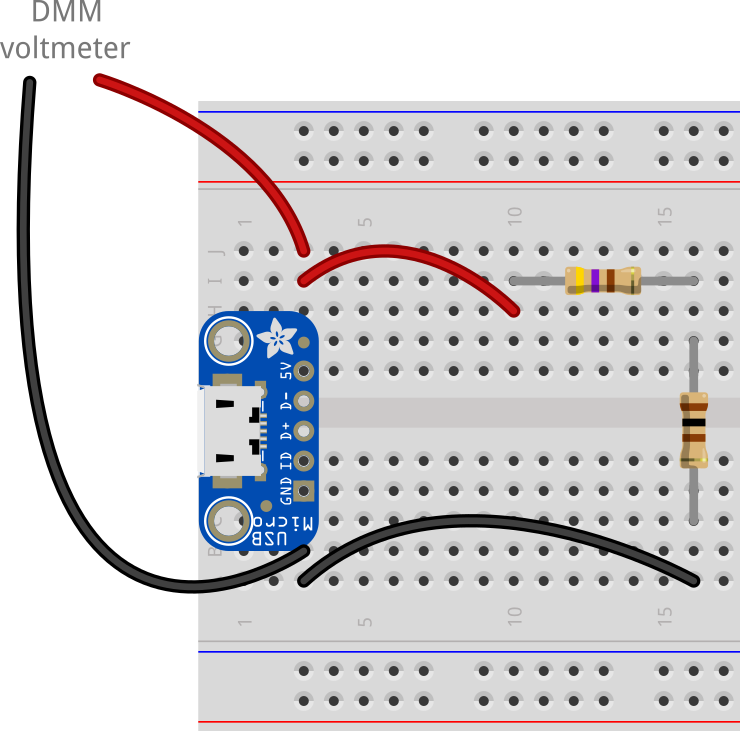
Voltage Divider - Measuring VS
Record the voltage measurement for VS on the results sheet. You only need to make this measurement once as we will assume it will stay constant throughout this experiment.
Move the voltmeter leads to first measure the voltage across R1 and then move them again to measure the voltage across R2. Record both of the measurements in the appropriate place on the results sheet.
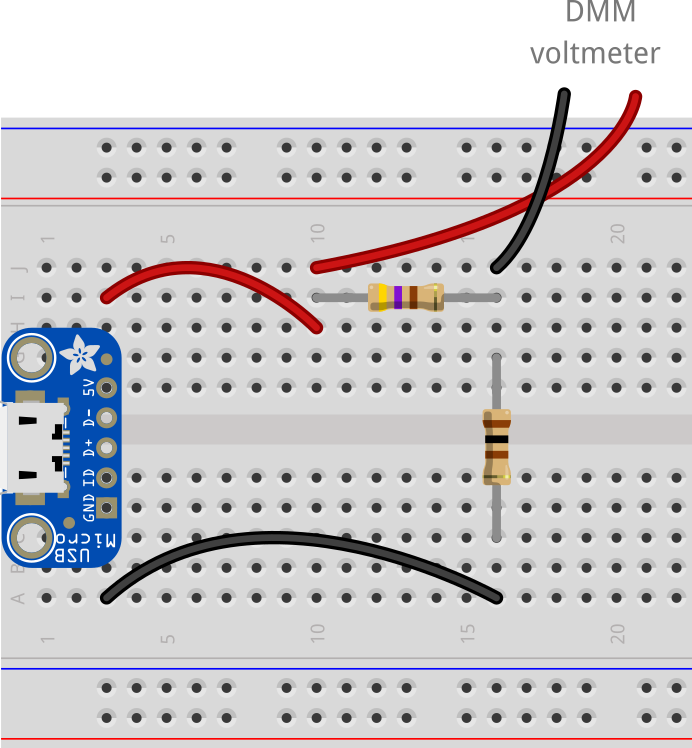
Voltage Divider - Measuring V1
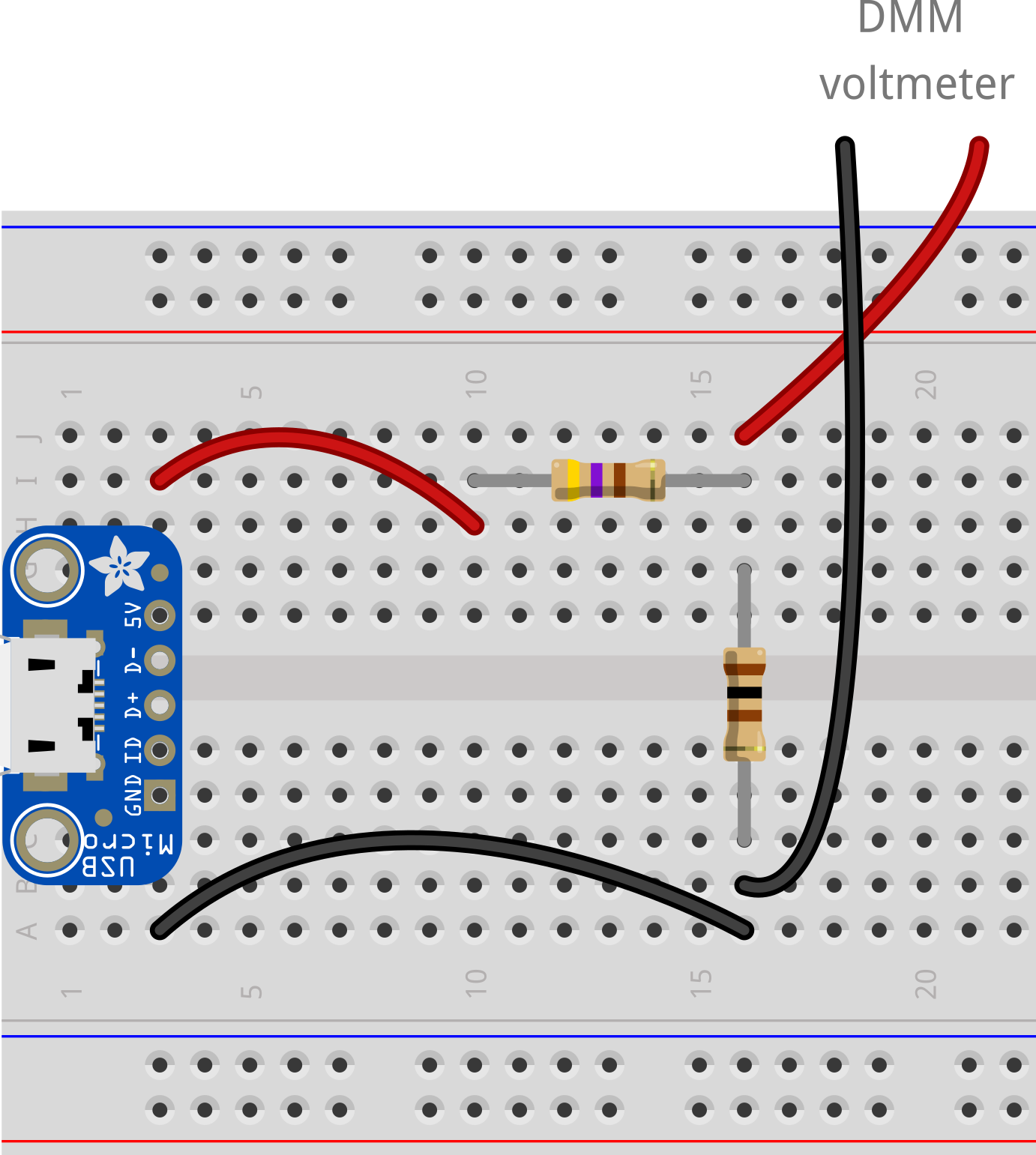
Voltage Divider - Measuring V2
Replace the resistor R2, first with a 470Ω resistor followed by a 1kΩ and 4.7kΩ and repeat the 2 voltage measurements as above for each resistor value making sure to record your measurements.
Restore the R2 resistor to 100Ω.
Remove the voltmeter from the circuit and then setup the DMM as an milliammeter to measure the circuits current.
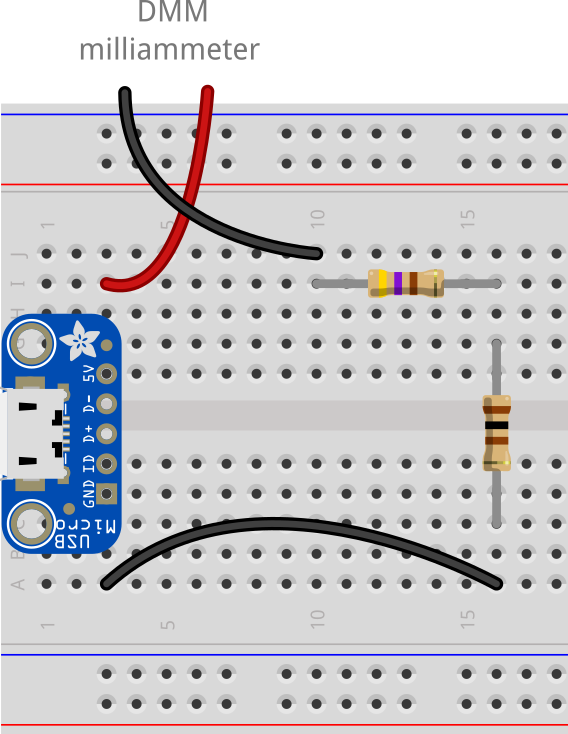
Voltage Divider - Measuring IS
Record the current measurement for IS on the results sheet.
Replace the resistor R2, first with a 470Ω resistor followed by a 1kΩ and 4.7kΩ and repeat the 2 voltage measurements as above for each resistor making sure to record your measurements.
Once all of the required measurements are obtained and checked, disconnect the circuit only leaving the 5V USB breakout connected on the breadboard.
2.4 Current Divider
Kirchhoff’s Current Law
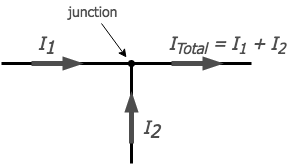
figure 9. Kirchhoffs Current Law
Kirchhoff’s Current Law (KCL) is another one of the fundamental laws used for circuit analysis. His current law states that for a parallel path the total current entering a circuit’s junction is exactly equal to the total current leaving the same junction. This is because it has no other place to go as no charge is lost.
In other words the algebraic sum of ALL the currents entering and leaving a junction must be equal to zero as: \(\Sigma I_{IN} = \Sigma I_{OUT}\).
This idea by Kirchhoff is commonly known as the Conservation of Charge, as the current is conserved around the junction with no loss of current.
Test the current source by connecting the circuit below and following the required procedures.
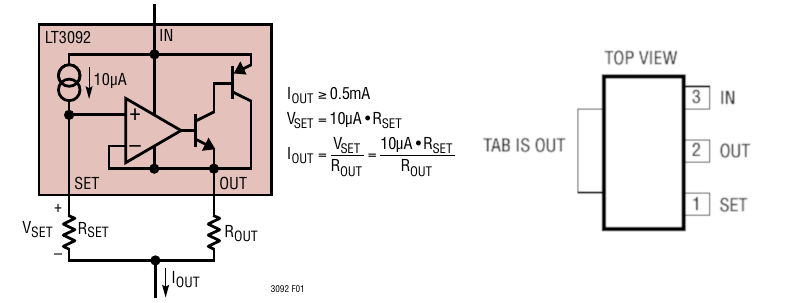
LT3092
Configure the LT3092 above on the breadboard as a 5mA current source using the following:
The LT3092 current source.

LT3092
A 10kΩ resistor as Rset at pin 1 (Set) of the device
A 20Ω resistor as Rout at pin 2 (Out) of the device, the other ends of both Rset and Rout need to get connected together.
Pin 3 (IN) of the device needs to get connected to the 5V of the USB Breakout board.
Connect the red probe of the DMM configured as a milliammeter to the Iout point in the diagram above. Connect the black probe to the GND pin of the USB Breakout board.
Your circuit should look something like this when completed.

current source circuit
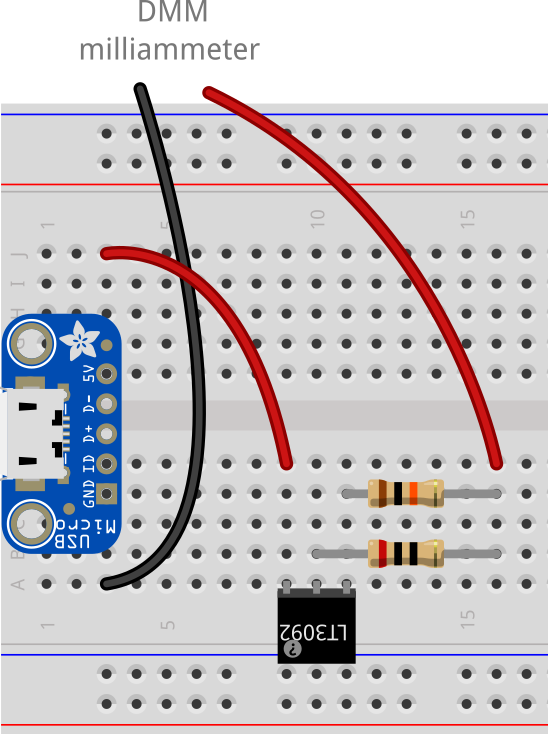
current source circuit
Note:
The current source is made up of 4 components:- The 5V source
- The LT3092 IC
- The 2 resistors
- The right side of the 2 resistors.
- The GND terminal of USB breakout board.
The current source is currently short circuited by the DMM as a milliammeter allowing the current to flow.
With the current source connected correctly you should get an approximate reading of 5mA on the DMM.
Experiment with Kirchhoff’s Current Law by connecting the circuit below and following the required procedures.
Click here to see a simulation demo of this circuit.

current divider circuit
Connect the circuit above using the following:
Use the 5mA current source you connected in the previous step.
Use a 470Ω resistor for R1 and a 100Ω resistor for R2. Use a jumper wire on one end to place them both in parallel.
Use the DMM as a milliammeter to measure IS.
It should look something like this when completed.
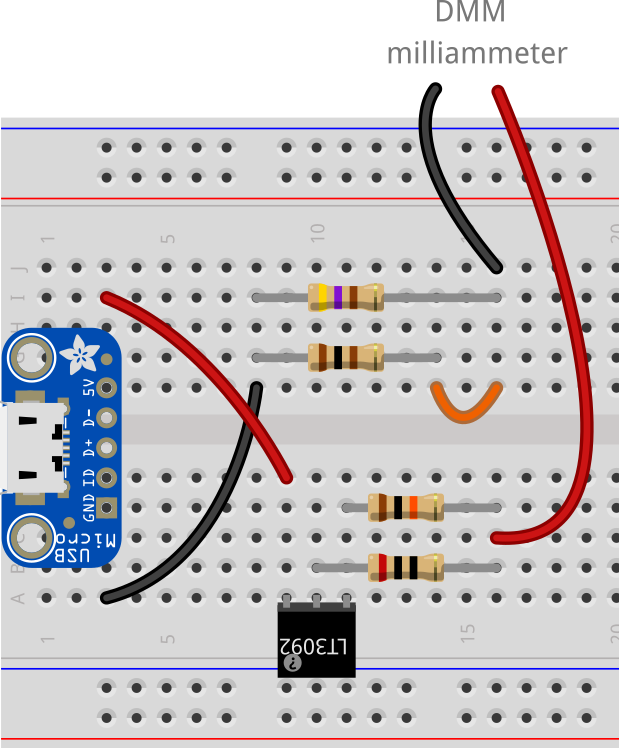
current divider circuit - measure IS
Record the current measurement for IS on the results sheet. You only need to make this measurement once as we will assume it will stay constant throughout this experiment.
To obtain a measurement for I1 you will need to reconfigure your circuit so the milliammeter is in the new position. It should look something like this when completed.
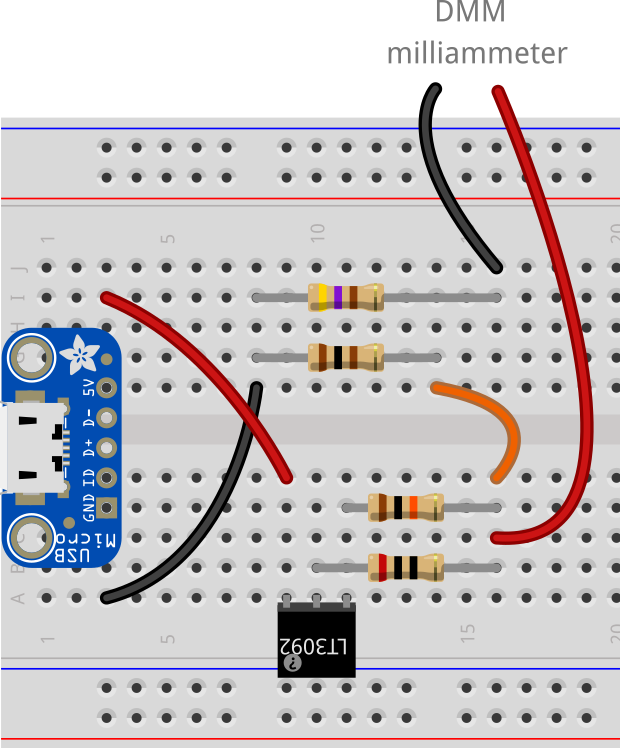
current divider circuit - measure I1
Measure and record the values on your results sheet for I1 for each of the 4 resistors (100Ω, 470Ω, 1.0kΩ, 4.7kΩ) each taking their turn as R2.
To obtain a measurement for I2 you will again need to reconfigure your circuit so the milliammeter is in the new position. It should look something like this when completed.
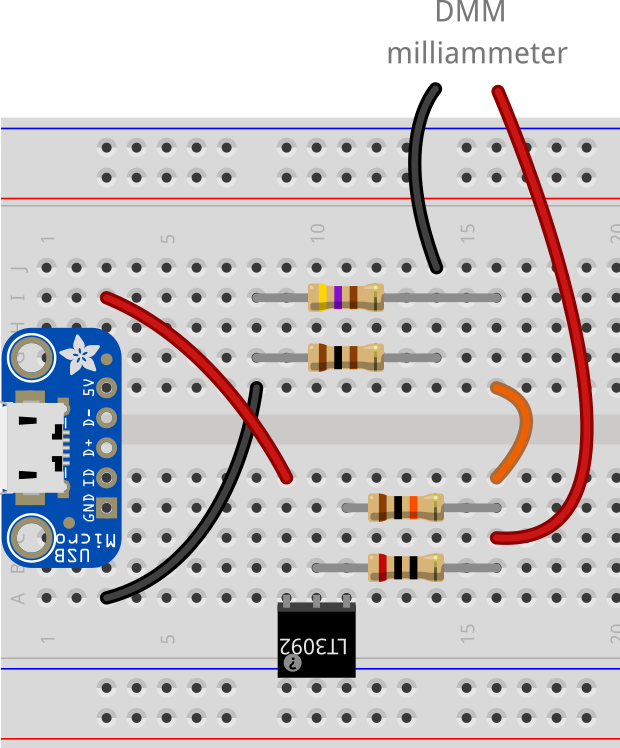
current divider circuit - measure I2
Now measurement and record the values on your results sheet for I2 for each of the 4 resistors (100Ω, 470Ω, 1.0kΩ, 4.7kΩ) each taking their turn as R2.
Once all of the required measurements are obtained and checked, disconnect the circuit only leaving the 5V USB breakout connected on the breadboard.
2.5 Potentiometer Divider
Experiment with a Potentiometer by connecting the circuit below and following the required procedures.
Click here to see a simulation demo of this circuit.

potentiometer divider circuit
Connect the circuit above using the following:
Use the already connected 5V USB power supply as the voltage source VS. Remember the supply is already on, so it is recommended to make the jumper connection to the 5V the last connection you do.
Use the 1.0kΩ potentiometer.
As we only have 1 DMM, first connect it as a voltmeter to measure the voltage across the voltage source VS.
The circuit should look something like this when completed.
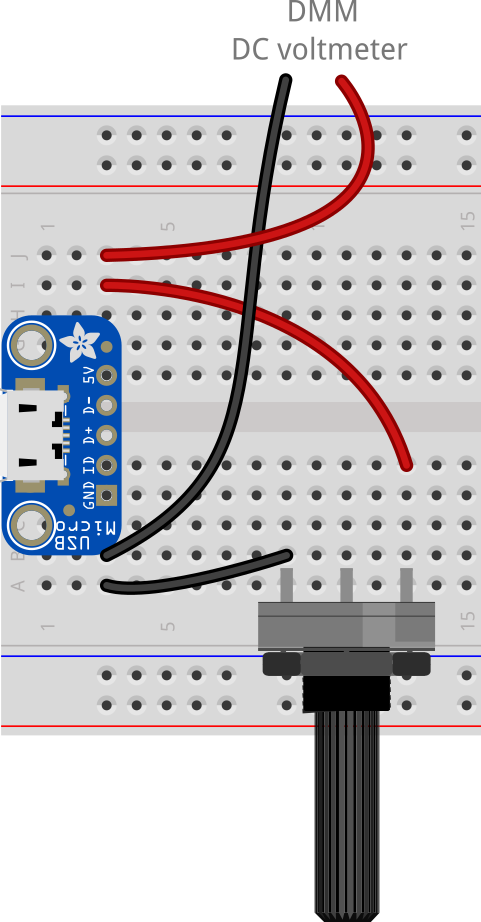
potentiometer divider circuit - measure VS
Record the voltage measurement for VS on the results sheet. You only need to make this measurement once as we will assume it will stay constant throughout this experiment.
For V1 and V2 you will need to move the voltmeter each time you change the potentiometers knob setting to record both voltages on the results sheet. The circuit will switch between the 2 diagrams below.
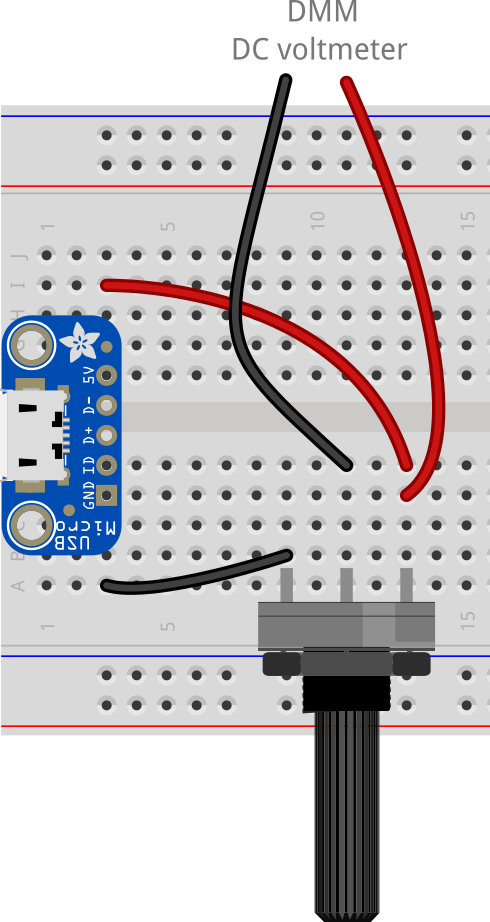
potentiometer divider circuit - measure V1
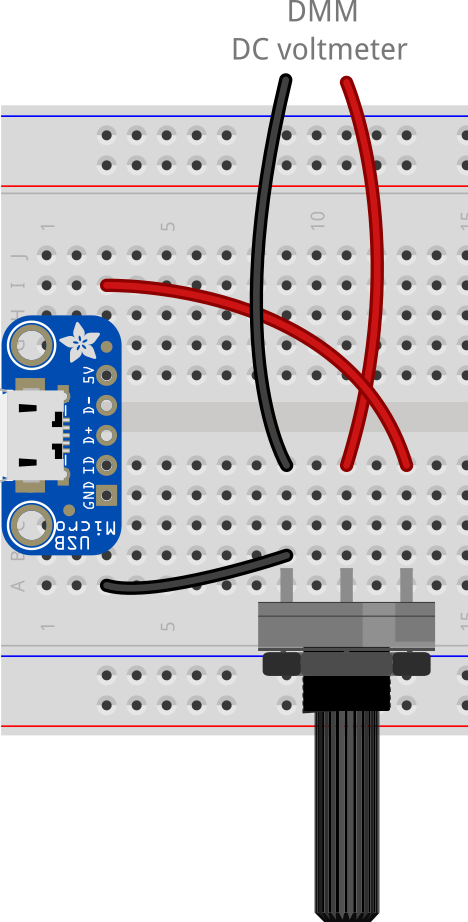
potentiometer divider circuit - measure V2
Turn the potentiometer knob until you obtain the V1 set-points of (0V, 1V, 2V, 2.5V, 4V, 5V) making sure to measure and record the values of V1 and V2 at each set-point.
Once all of the required measurements are obtained and checked, disconnect the circuit only leaving the 5V USB breakout connected on the breadboard.
2.6 Loading Effect
Loading Effect
The loading effect is to what degree a measurement device impacts the electrical properties of the circuit under test (ie. voltage, current, resistance). Ideally the piece of equipment will have a negligible effect on the circuit and therefore give you the correct readings. However, under certain conditions the measurement device can have significant effect and alter the normal operation of the circuit and therefore give your readings an unexpected result if not accounted for.
2.6.1 Voltmeter Loading
Voltmeter Loading
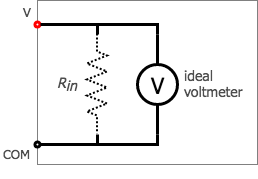
Non-ideal Voltmeter
An ideal voltmeter imposes no load on the circuit being measured so as to not disturb the circuit. In practice, voltmeters draw some current and hence some small amount of load to the circuit affecting results.
So in an ideal voltmeter, the resistance of the meter is infinite.
In practice, voltmeters originally had resistance of several thousand Ohms, 30KΩ or 100KΩ was common. The resulting power used was required to deflect a moving needle galvanometer type meter.
Later electronic meters with input amplifiers such as vacuum tube and transistorized volt meters drew much less current with very high impedance and active amplifiers to drive the meter movements; today’s digital multimeters typically have greater than 10MΩ input impedance.
Experiment with Voltmeter Loading Circuit by connecting the circuit below and following the required procedures.
Click here to see a simulation demo of this circuit.

voltmeter loading circuit
Connect the circuit above using the following:
Use the already connected 5V USB power supply as the voltage source VS. Remember the supply is already on, so it is recommended to make the jumper connection to the 5V the last connection you do.
Use two 10MΩ resistors in series as R1 and R2.
Use the DMM as the Non-Ideal Voltmeter to measure the voltage across R2.
With the Non-ideal Voltmeter across R2 measure and record the voltage.
Move the Non-ideal Voltmeter to measure the voltage across R1 and record the voltage again.
Now move the Non-Ideal Voltmeter to measure the voltage across VS and record the voltage reading once again.
Once all of the required measurements are obtained and checked, disconnect the all of the equipment.
2.7 Cleanup
Congratulations, you have completed the experimental part of the the laboratory. Before cleaning up, I’d suggest going through your results to check that you have completed everything and that your results make sense. If you find any issues, I’d suggest resolving or making a note of it now. If you are not continuing to work with the equipment please disconnect everything and put it away to prevent it from getting damaged.
3 Post Lab
The following is what you are expected to complete and submit for grading for Lab 1 before the deadline.
The completed Lab 1 - Results sheet template provided at the beginning of this lab manual under Equipment required. This sheet should include the following:
- Your name, student ID and CCID.
- All of the required measurements from the lab procedures.
- All of the required calculations as discussed below.
- The required plots as discussed below.
The Lab 1 - Results sheet needs to be submitted to the Submit (Lab 1 - Results) link on eClass as a pdf document .
- Complete the online Quiz (Lab 1 - Post Lab) on eClass.
3.1 Calculations
For these calculation you only need to provide the answers in the space provided on your results sheet, you do not need to show your work.
For Ohm’s Law and Power calculate the resistance from your voltage and current measurements for each resistor.
For Ohm’s Law and Power calculate the power dissipated in each resistor from your voltage and current measurements for each resistor.
For the Voltage Divider calculate the sum of the voltage across the 2 resistors for each R2 value.
For the Voltage Divider calculate the power dissipated in each resistor and the total power supplied by the power source for each circuit.
For the Current Divider calculate the sum of the current through the 2 resistors for each R2 value.
For the Current Divider calculate the power dissipated in each resistor and the total power supplied by the power source.
For the Potentiometer Divider add the 2 voltages you measured for V1 and V2 to show that it equals the supply voltage you used for this circuit.
For Voltmeter Loading add the 2 measurements you obtained to see if they add to supply voltage you used for this test.
3.2 Plots
To create your plots you can use whichever software you would like (Excel, Matlab, etc), export your plot as an image and import it into your Lab 1 - Results sheet in the appropriate place.
Your plots should include:
- A Plot title
- Label your axes and show what unit of measure is used.
- Include a marking for your datapoints.
- Include a line between your datapoints in the same series.
- Include a legend.
- Make sure your scales are appropriate and visible.
Voltage Divider (R1 = 470Ω) - Voltage Plot: For your Voltage Divider results, plot a series for each voltage: source voltage, R1 voltage and R2 voltage versus the resistance value of R2.
Voltage Divider (R1 = 470Ω) - Power Plot: For your Voltage Divider results, plot a series for each power: the source power, the R1 power dissipated and the R2 power dissipated versus the resistance value of R2.
Current Divider (R1 = 470Ω) - Current Plot: For your Current Divider results, plot a series for each current: source current, R1 current and R2 current versus the resistance value of R2.
Current Divider (R1 = 470Ω) - Power Plot: For your Current Divider results plot a series for each power: the source power, the R1 power dissipated and the R2 power dissipated versus the resistance value of R2.
3.3 Questions
Complete the online Quiz (Lab 1 - Post Lab) on eClass.